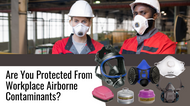
Are you protected from workplace airborne contaminants?
Posted by Safety Supplies Canada on 7th Apr 2025
Exposure to microscopic particles can pose serious health risks, including respiratory illnesses and long-term lung damage. Despite this knowledge, many workers are unaware of their exposure, or refute the need for respiratory protection citing discomfort or minimal risk. Health and Safety, its regulations, standards and the technology that has been developed to protect workers has come a long way since the Romans used animal bladder skins to protect workers in mines from red lead oxide dust. (Eww!)
Today, respiratory protection is manufactured with several factors taken into account. Workers have options when it comes to sizes, types of material used, as well as the levels of protection needed in order to ensure their safety is not in question. 
Needless to say, lack of protection is not the leading cause of continued respiratory illnesses occurring in the workplace - it is the misunderstanding of the level of risks employees face in their day to day jobs.
As such, we wanted to highlight both common and uncommon work environments that could be leaving you at risk. Workers in overlooked industries ( scroll lower down in this blog to see if your industry is listed here!) should be more aware of their respiratory risks and take appropriate precautions.
Want to know more about the levels of protection needed? Keep reading! We list our recommendations below! Or SHOP NOW!
Common Airborne Particles
1. Dust and Debris
Dust is a prevalent airborne contaminant in construction, woodworking, and manufacturing industries. It consists of tiny solid particles that can become airborne during cutting, sanding, or grinding processes. Inhalation of excessive dust can lead to conditions such as pneumoconiosis or chronic lung disease.
2. Fumes and Vapors
Welding fumes, metal oxides, and chemical vapors are common in industrial settings. These fine particles and gases result from high-temperature processes such as welding or chemical reactions. Exposure to metal fumes like manganese and hexavalent chromium can cause severe respiratory issues and neurological effects.
3. Mists
Mists are tiny liquid droplets suspended in the air, often found in painting, pesticide application, and metalworking processes. Prolonged exposure to oil-based or chemical mists can lead to lung irritation and chemical toxicity.
4. Mold and Allergens
Mold spores, pollen, and other biological contaminants are common in damp environments, agricultural settings, and healthcare facilities. Inhaling these allergens can trigger asthma attacks, allergic reactions, and respiratory infections.
5. Chemical Gases
Industrial environments often contain harmful gases like ammonia, chlorine, and formaldehyde, which can cause severe irritation or long-term lung damage. These gases require specialized protection to prevent respiratory exposure.
Recommended Respiratory Cartridges



Selecting the appropriate respiratory cartridge depends on the type of airborne hazard present. Here are the most common types:
1. Particulate Filters (P100, N95, R95, etc.)
- N95: Protects against non-oil-based particulates, such as dust and mold.
- R95: Offers protection against both oil- and non-oil-based particles for limited use.
- P100: Provides the highest level of particulate filtration, effective against dust, fumes, and biological contaminants.
2. Organic Vapor Cartridges
- Designed for protection against organic vapors, such as solvents, paint fumes, and pesticides.
- Commonly used in painting, chemical handling, and industrial cleaning tasks.
3. Acid Gas Cartridges
- Effective against hazardous gases such as chlorine, hydrogen sulfide, and sulfur dioxide.
- Essential in chemical plants, laboratories, and wastewater treatment facilities.
4. Combination Cartridges
- These cartridges offer protection against multiple hazards, such as particulates and gases.
- Ideal for workplaces where exposure to both dust and chemical vapors is a concern.
5. Multi-Gas Cartridges
- Designed for protection against a broad range of toxic gases and vapors.
- Suitable for emergency responders and hazardous material handling professionals.
Overlooked Jobs That Require Respiratory Protection
While industries like construction and manufacturing are known for requiring respiratory protection, many other jobs involve exposure to harmful airborne particles without workers realizing it. Some overlooked professions include:
1. Cleaning and Janitorial Services
- Workers using chemical cleaners, mold removers, and disinfectants may inhale harmful fumes and dust in poorly ventilated spaces.
2. Baking and Food Processing
- Exposure to flour dust, spice powders, and food additives can cause respiratory issues such as baker’s asthma.
3. Agriculture and Farming
- Pesticides, grain dust, and mold spores in barns and silos pose respiratory risks, especially in confined spaces.
4. Veterinary and Animal Care
- Animal dander, bacteria, and disinfectant fumes can lead to respiratory problems over time. ( Groomers' lungs are a thing!)
5. Auto Repair and Body Shops
- Paint fumes, metal dust, and solvents used in vehicle maintenance can be hazardous.
6. Cosmetology and Nail Salons
- Chemicals in hair dyes, nail products, and sprays can generate toxic fumes.
7. Printing and Graphic Design
- Ink solvents, toner dust, and spray adhesives contribute to poor indoor air quality.
8. Waste Management and Recycling
- Handling and sorting waste exposes workers to mold spores, dust, and biohazards.
9. Warehouse and Logistics Workers
- Dust from packaging materials, forklift exhaust, and stored goods can cause respiratory issues.
Any time spent breathing in dangerous contaminants is a risk to your health that need not be taken. Visit our online shop today to choose the right respiratory protection.
Do you still have questions? Our customer service team is happy to help you out!
Call Us : 1-855-960-7369 or send us an email at orderdesk@safetysuppliescanada.com
